
AudioGetAwayCar Photo
This is Syracuse, not Malta, but the pits would be just as full on a Friday at Alabany - Saratoga Speedway.
BILL'S
[Somewhat] WEEKLY COLUMN/BLOG PAGE
BILL’S BACK IN TIME
By Bill Ladabouche
PIG
FLAGS, SHRINKING TRACKS ?
WHAT THE HELL IS GOING ON HERE ?
My former student and friend, Bob Sturgeon, after sitting through a tense town school meeting in which there was one vote after another, finally got to his feet in the top row of the bleachers at the high school gym and roared, “What the hell is going on here !?” Well, in that case, the school budget supporters and the school officials had hoodwinked their way to getting a budget passed by confusing the legions of opponents sitting in the crowd.

AudioGetAwayCar Photo
This is Syracuse, not Malta, but the
pits would be just as full on a Friday at Alabany - Saratoga Speedway.
But in racing these days, it is not so simple to see the cause of the s?!# and corruption going on at the local bullring. Houston, We have a mess! I just went to a race where they were excited because 22 modifieds showed up for a race. Granted, just a couple of hours down the road, there is a track getting so many cars for a program they don't know what to do with them – but that is damnably rare these days. The real situation today more resembles some of the tracks I go to.
The track pleased with the 22 mods had a crowd of maybe 400 fans, if they were lucky. They were hosting a touring group which could not approach the field sizes it used to boast of eight years ago. My other regular track still has full fields of at least two of its divisions, but these “full fields” are just enough cars to fill the field, whereas it used to have over a dozen cars that didn't qualify due to the sheer size of its divisions.

Pinterest.Com
Thunder Road is still used to seeing
full fields almost at every event. Although the fields used to be even larger,
it is doing superbly compared to a vast majority of its competition. Below –
ACT's dogged attention to tire use is one of the reasons the cost of racing
there is still reasonable
[albeit, they now use American Racers].

Granitestripe.Com
We all throw up our hands and despair about how it is all going: small fields, small crowds, skyrocketing costs, and the tracks that are surviving often doing through the pit admission and through selling sponsors their own night. Massachusetts once had at least a dozen tracks running at once - now it has one; Vermont once had 22 tracks operating simultaneously – now it has 3; there doesn't seem to be a completely healthy track in New Hampshire; and I am sure Maine has some similar problems.
They all wish they could be Albany – Saratoga Speedway, in Malta, NY – the track with competitors coming out of its ears. Promoter Howie Commander went into the terminally – ill track, leased it, tore up the hated pavement, and got it going [actually better than his original Lebanon Valley at this point] partly by expertise and partly by falling into the s$#@! and coming out smelling like a rose. It was the place to be in dirt – loving New York state. But looking at Malta doesn't address the over-riding problem elsewhere.

Albany-Saratoga Speedway Site Photo
Commander's decision to try Albany-Saratoga as a dirt track again turned out to
be about as fortuitous as when C.J. Richards converted to the 358's years ago.
Below – A view of the pits at Catamount during what arguably could be called its
best era; and they are packed.
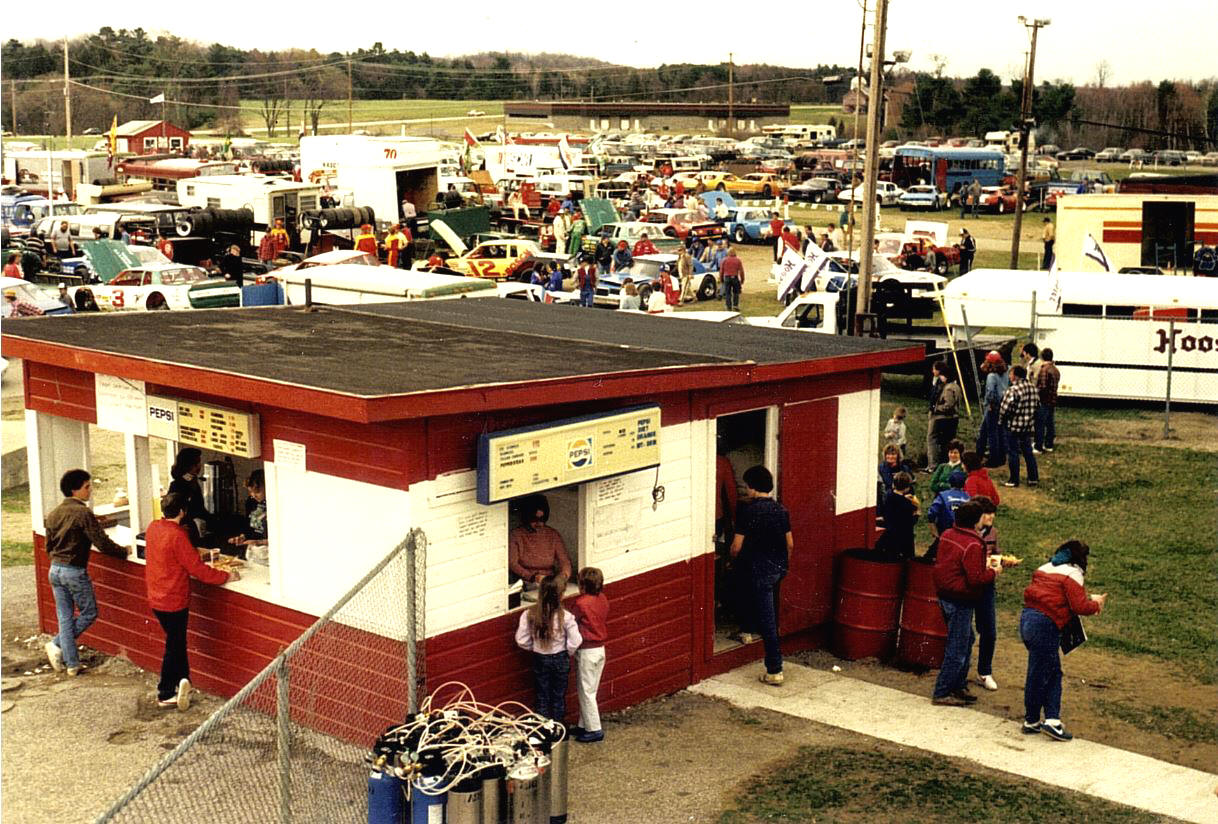
Norman Morley Photo
There was a time when Catamount Stadium and Thunder Road were featuring huge fields of late model sportsman cars, while enjoying at least one support division or more with a good quantity of entries. Devil's Bowl, then back to dirt, was the place to be on a Sunday night because it was almost the only show in the region on that night. Bear Ridge was loaded with the real old coupes, and many of the New York tracks in this immediate area were also flourishing. There was more money then, and the economy would not tank for another decade and a half or so.
Courtesy of George Hill
Bear Ridge had no shortage of coupes
even into the 1970's. Below – Airborne, despite many changes in track name and
even more changes in the headlining division, managed to keep a full pit area
and decent crowds for years.
Bob Mackey Photo Courtesy of Mike Watts, Sr.
I have heard so many ideas on what has caused this malaise. It is fairly obvious that racing costs have skyrocketed while payouts have shrunk. Then, too, there is that propensity by most racers to spend themselves into oblivion. Some of the old hands who contribute to chat sites and message boards that cater to the old school bemoan the facts that : a.) racers seldom build their own stuff now; b.) a lot of today's drivers are rich kids spending their family's money to climb into a prepared car without having gotten their hands dirty all week; c.) cars used to be build from and repaired from parts gotten out of salvage yards – now a lot of equipment has be sent back to the builder's shop for repair; and d.) the push to level competition has made many racing divisions a field [not very] full of cookie cutter cars, all alike.
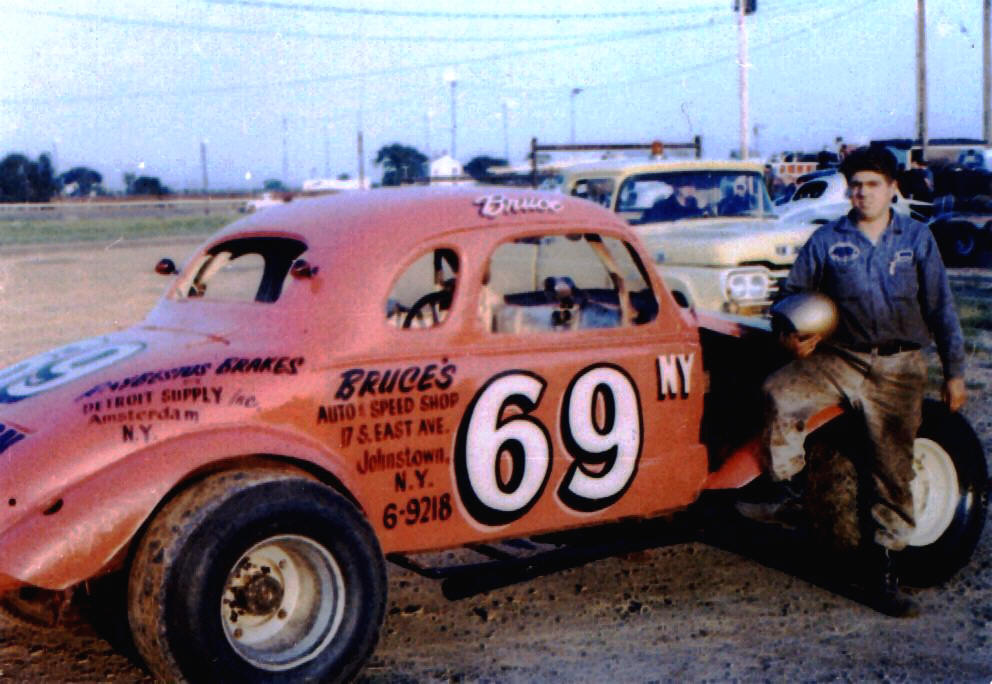
Ladabouche Collection Likely John Grady Photo
A young Bruce Dostal would not
fit into the mold of today's young
drivers. He looks like he may have worked a bit on the car. He'd run it on both
the dirt at Fonda and the pavement at Malta.
Some of their points are certainly valid; we just can't lump all racers into one group. In one of the few moments when I got Tom Curley, ACT promoter, to talk much with me, he made some very valid observations as to why tracks, crowds, and fields are shrinking in most parts of this region. Firstly, Curley pointed out that stock car racing is no longer a new sport. It has its roots in the late 1940's, burgeoning in the 1950's, and growing steadily until the mid 1980's. That is hardly a new entertainment venue any more.
A second point Tom made has to do with today's consumer. Especially referring to kids, they can get more immediate and relevant thrills via computer games, video games, and even remote control racing equipment than by going to a race track that is probably not nearby. While you will always have your motorheads in all high schools, today's young people are more drawn to the kid of motor activity you might find in X Games. Hence, except for that age – old use of the local race track as a place to troll for the opposite sex, the stock car race crowd is an aging dynamic.
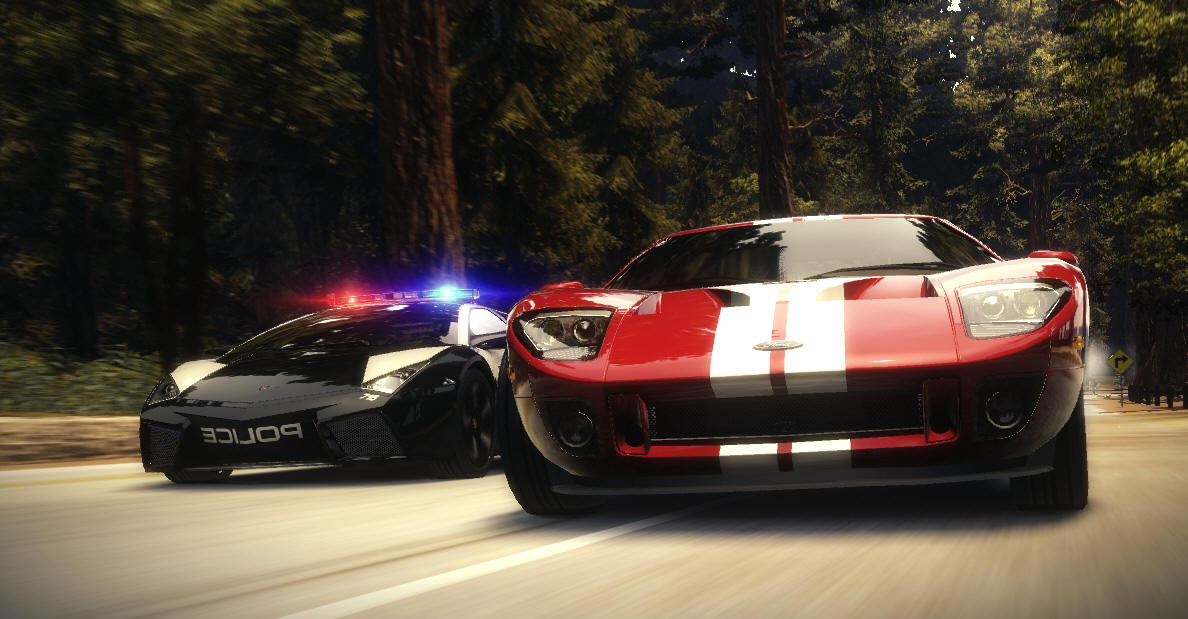
EA Sports.com Site Photo
Between being able to “race” in your
own living room on games like EA Sports' Hot Pursuit and watching folk heroes do
insane things with a car in the X Games[below], the need for today's young
person to travel to the local track is not as great.
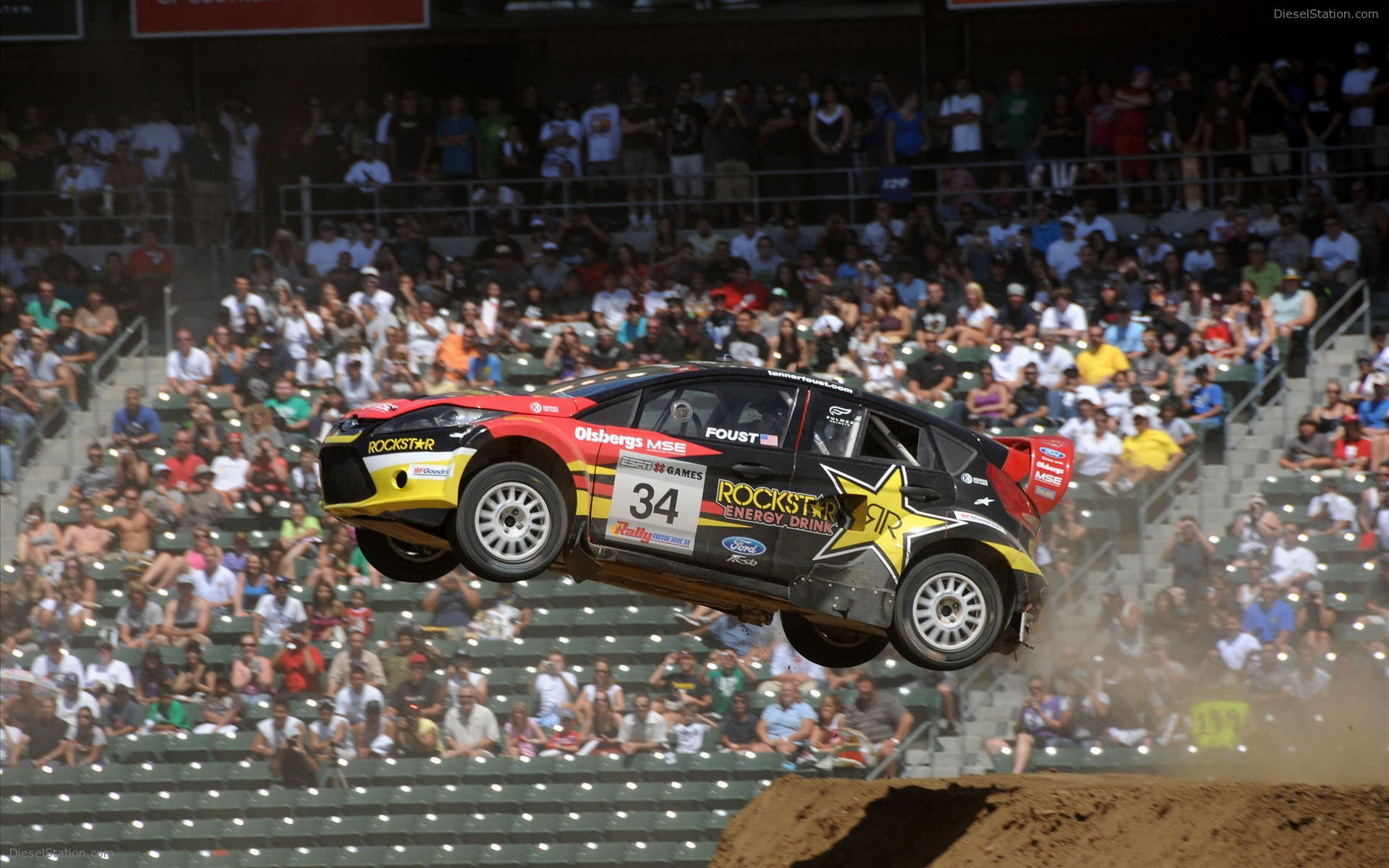
DieselStation.Com Photo
If there is anyone who has done more to keep stock car racing healthy and to stem the tide of dying race tracks, it is only fair to say I'd have to see them. Tom Curley, through single – minded devotion [at the cost of his health] has worked nearly without stop since the late 1970's to stimulate racing in his region. He is certainly no fan of me and I don't always agree with some of the heavy – handed way he can treat people, but I cannot deny he has accomplished amazing things over the years.
When Curley strolled back onto the racing the racing scene at Catamount in the '70's with his preppy attire and direct approach, he got that track and Thunder Road going again while beginning to introduce the touring idea to the late model community there. What resulted, of course, was the memorable “Beer tour era” that revived the late model sportsman racing and increased involvement from two tracks in one state to – at various times – numerous tracks in a number of states and Canada.
Bob Doyle Photo Courtesy of Cho Lee
Tom Curley, not long after appearing
on the scene at Catamount and T Road. Here he poses with long-time offical
Archie Blackadar and former driver – turned official Len Stockwell. Below-
Thomas “T Bone” Curley, in the Frances Lackey 44 out of Northfield, VT. I recall
him spinning out a lot during the brief time I watched him at Catamount.

Courtesy of Cho Lee
There will never be total consensus on whether his split with NASCAR was a good idea or not, but being able to operate from his own platform [the American – Canadian Tour] allowed him to institute those practices with which he could try to keep racing costs down as much as possible and keep the level of competition high. It is a thin line to walk in arguing whether it is better now – with ACT tires, spec motors, and all the rest or whether the days of running your own choice of tire, your own motor, etc. was more interesting.
More interesting ? - the old days; but how long would the sport have survived as the bigger spenders began to take over and dominate ? Not long. We could see it coming at the end of the Catamount era as the Skip Farrrells, the EJ Prescotts, and the other big dollar teams were squeezing out the lower budget teams almost entirely. Today's ACT fields have cars with the same motor, the same tires, with bodies one cannot distinguish save the decals on the front and back, and same shocks, and whatever else is regulated. The cars are so even, it makes racing sometimes predictable. But, while, other tracks are begging for cars, Curley's track still has fairly full fields.
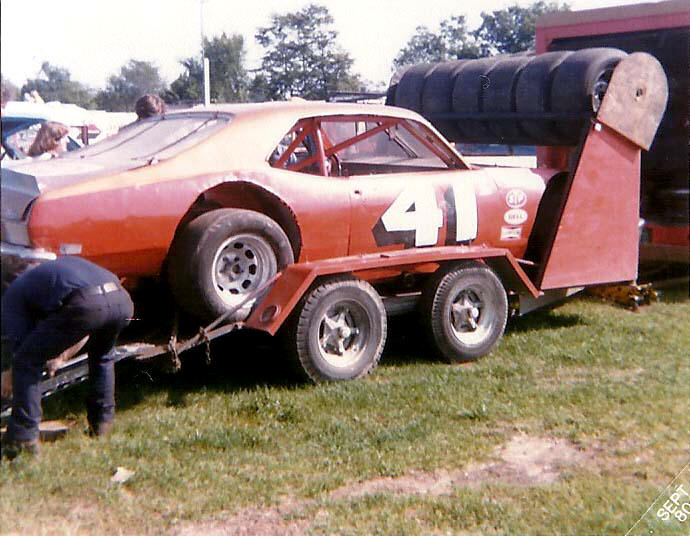
Courtesy of Rich Palmer
Tom Curley saw the sport grow not
only in stature but in cost. These two photos of local Vermont driver Jamie
Aube's
operation were within about five years of each other and illustrate how the
stakes had been raised.
Norman Morley Photo
The other factor that makes today's racing less fun is the almost total lack of “characters”, as compared to the old days. But that is not a promoter's fault. Racing is more of a business now, and with that comes an atmosphere that discourages a lot of free spiritedness, [The sponsor wouldn't like it]. Tracks try very hard to play up any uniqueness they can find in the pits, employing a few colorful nicknames, but there isn't much to work with these days like when we had Chester T. Wood, the prankster Rene Charland, Al “The Animal” Simoneau, Gaston Desmarais with the green light he would switch on when he was convinced he had the race won, or someone like Oxford's Ray “The Boulder” Stone.
Then too, it is harder to be flamboyant, and that is no promoter's fault either. Flaggers like Archie Blackadar and Danny Rumpf used to start races on the track with the uncoming cars. Chet Hames, the Fonda starter, was one of the most colorful ever, strutting and jumping around throughout the whole race. Native American flagger Tex Enright wore an outfit that would make a 1960's country and western singer jealous when he ran the show at Orange County, Middletown, NY. With everything electronically calculated today and shows carefully run, Curley's flaggers like Mike Wilder are running the show from behind a fence with instructions being constantly shouted to them via earphones. But, Curley's tight show has be done today, with today's impatient, short – attention – span crowds.
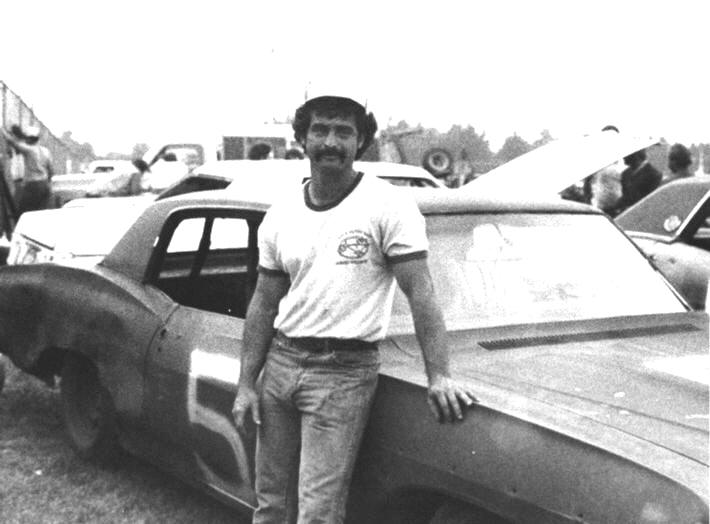
Courtesy of Cho Lee
Al Simoneau was one of several street
stock drivers in the early '80's who was quite the character.
Below – Perhaps the ultimate character was Orange, VT native Chester T. Wood.
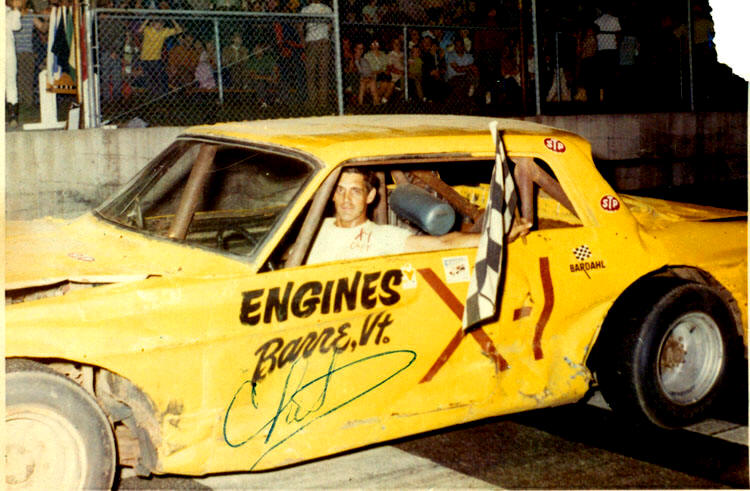
Courtesy of Steve Pecor
We do have to remember that Tom Curley brought us “the pig flag”, a thing largely unique in all of racing. Used to get after a driver who is using too much track at the crowded Thunder Road, it ensured the black flag was not being overused or wrongly used to control track hogs. Tom has done about everything he could do to keep his beloved track and circuit going, and he has pretty much succeeded. The Tiger Sportsman class is in a low ebb, right now, but steps are being taken to lower racing costs. It will take more than a season to grow it back.
I have not generally done opinion pieces since my days at Speedway Scene, which ended in the 1980's; but, given my concern for Tom's health I wanted to give him credit where it is due. Thunder Road might not even be here today if he had not taken hold hard, made some unpopular decisions, and then saw them through. The hill full of fans at the Memorial Day Classic, despite a high admission fee, is testimony to what Tom Curley has managed to do. He should feel proud, and I wish he could feel a lot better, physically.
Courtesy of Circle Track Racing
I was asked once by someone at a race car show in central New York - “Do you guys seriously use a pink flag up there ?” I had to answer “ayuh”.Please email me if you have any photos to lend me or information and corrections I could benefit from. Please do not submit anything you are not willing to allow me to use on my website - and thanks. Email is: wladabou@comcast.net . For those who still don’t like computers - my regular address is: Bill Ladabouche, 23 York Street, Swanton, Vermont 05488.
AS ALWAYS, DON’T FORGET TO CHECK OUT MY WEBSITE
www.catamountstadium.com
Return to the Main Page
Return to the Main News Page
Return to the All Links Page
Return to the Weekly Blog Links Page